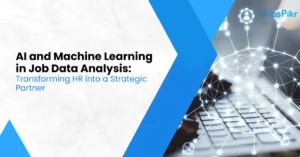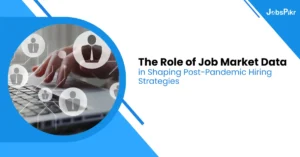Building an effective recruitment strategy plan to hire the right talent for your business goes beyond identifying available positions at your company, putting up job postings on job boards, and upgrading the career page on your website. It even goes beyond hiring recruiters to help you fill positions with the best candidate. Job data scraping helps recruitment firms build effective strategies.
To build a truly effective recruitment strategy plan, you need to consider a host of things, including your company’s long-term growth plan, the market forecast for your industry, your competitors’ hiring strategy and methods, market competitiveness, etc.
You need to build a program that allows you to anticipate future recruitment needs, build a talent pool, and continually monitor hiring trends and tactics in the industry like that mentioned above. And that’s a tall order. But don’t worry; with the right tools, it’s more than achievable.
This article will explore what a recruitment strategy plan entails, the importance of data for recruitment purposes, and how to obtain recruitment data through job data scraping to fuel your recruitment strategy planning efforts.
Defining an Effective Recruitment Strategy Plan
A recruitment strategy plan is a roadmap defining your current employee needs, future employee needs, how they tie into your company’s long-term vision, and your proposed methods for filling these needs. Simply put, it is a plan to keep your business in a constant supply of top talent.
Let’s talk about what constitutes an effective recruitment strategy. If you want your strategy to be effective, you need to consider many data sets like market forecasts, long-term growth plans, competitor tactics, etc. So when you consider all these data sets and use them in building a recruitment plan, what do you get? Here are five elements that an effective recruitment strategy should have:
- Employee base: Your strategy must define the optimal number of employees your company needs and the number you will need at each successive stage of growth in your growth plan.
- Expansiveness: An effective strategy needs to be expansive, covering present recruiting needs and future, yet-to-be-identified ones. It must contain provisions for emergency openings, unanticipated expansion, and market fluctuations. Your strategy has to keep you ready for anything.
- Structured outreach channel: A targeted recruitment plan needs well-defined channels for reaching out to prospective employees and making the public aware of openings in your company. Your channel could be job boards, career websites, or a social media platform like LinkedIn or even using recruiters. Different channels work better for different businesses. Whichever works best for your business, your recruitment strategy must have a structure to access the channel and reach out to people when the need arises.
- Smooth onboarding process: Recruitment does not stop when the employee signs a contract. Your recruitment plan must include a method for smoothly easing your new hires into the company culture.
- Retention plan: Most importantly, your recruitment strategy plan must contain a retention strategy to help you keep hold of your current employees. Your ability to keep the employees you already have has a lot of impact on recruiting new talent. Your retention plan should include above industry standard pay (or matching the industry standard, at least), a good benefits package, excellent workplace culture, etc. All these help to build your credibility as an employer and make it that much easier to recruit new people when needed.
These are five things that should make up your recruitment strategy to make it as effective as possible.
Why Do You Need To Gather Recruitment Data?
Data is the lifeblood of business decisions, and recruitment is a series of decisions being made continuously.
Therefore, to create an innovative recruitment strategy that contains all the elements mentioned above, you need data—copious amounts of it. For example, you need data on what the market will do, what your competitors are doing, how prospective employees are marketing themselves, and how job postings are structured.
However, obtaining this data on your own can be a little complicated. Much of the candidate and job data available, especially on a job posting aggregation website, is cluttered, unstructured, and almost unusable. This is because these sites are mostly concerned with the volume of job postings rather than quality. So you need a reliable way to obtain the data you need to develop a recruitment strategy plan.
Developing a Recruitment Strategy With Web Scraped Data
One of the best ways to easily gather the data you need to build a good recruitment plan is through web scraping bots. So, what is job data scraping? Have you ever done a google search and gathered information from the results for your use (I’m quite certain you have)? Or gathered comments from a social media post to determine opinions on a topic? Then you have scraped the web. Job data scraping at the micro-level is simply gathering data from the internet. What web scraping bots do is take this activity to the macro-level, allowing you to extract large volumes of data from the internet in a short time. Web scraping bots use technologies such as APIs and multiple proxies to automate your data extraction activities, allowing you to collect loads of data in real-time.
Job data scraping is an effective means to gather most of the external data you need to formulate your internal recruitment strategy. Many HR departments already collect data for their employee management processes this way, so it should be a short leap to using scraping to collect recruitment data.
Data obtained from web scrapers come in formats that can be used immediately, so you can instantly integrate the data into your development process. For example, data like market forecasts can be collected with web scrapers, analyzed, and used to predict what the job market will be like in the future, making it easy to build a recruitment plan that considers future trends.
Apart from collecting data for your recruitment strategy, it would be best to track some metrics to determine how well your current strategy works and where you need to make changes. Some of the metrics you need to track include candidate experience metrics, speed and cost metrics, hiring quality metrics, etc. These metrics make it easy for you to know what is working for you and what is not working. And you can use web scraping to track all these metrics by using APIs to scrape data in real-time and at frequent intervals.
Final Thoughts
Creating a recruitment strategy plan that will continuously fulfill your employee needs when you need them used to be a pipe dream in previous years. You had to go through recruiters, use online bulletins, do all sorts of advertising, then fold your hands and hope the best candidate would apply. However, with the advent of big data operations and data collection tools like job data scraping bots, it has become easier to gather data on the recruitment process, determine what job seekers are looking for and tailor your vacancies to attract the best fit. And at PromptCloud, we aim to make it as easy as possible for you to join this trend and revolutionize your recruitment plan with big data.




